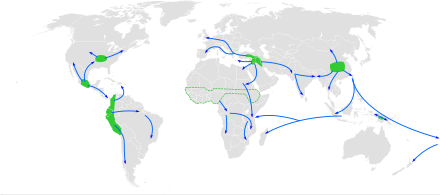
The Neolithic or New Stone Age (from Greek νέος néos 'new' and λίθος líthos 'stone') is an archaeological period, the final division of the Stone Age in Europe, Asia, Mesopotamia and Africa (c. 10,000 BC to c. 2,000 BC). It saw the Neolithic Revolution, a wide-ranging set of developments that appear to have arisen independently in several parts of the world. This "Neolithic package" included the introduction of farming, domestication of animals, and change from a hunter-gatherer lifestyle to one of settlement. The term 'Neolithic' was coined by Sir John Lubbock in 1865 as a refinement of the three-age system.[1]
The Neolithic began about 12,000 years ago, when farming appeared in the Epipalaeolithic Near East and Mesopotamia, and later in other parts of the world. It lasted in the Near East until the transitional period of the Chalcolithic (Copper Age) from about 6,500 years ago (4500 BC), marked by the development of metallurgy, leading up to the Bronze Age and Iron Age.
In other places, the Neolithic followed the Mesolithic (Middle Stone Age) and then lasted until later. In Ancient Egypt, the Neolithic lasted until the Protodynastic period, c. 3150 BC.[2][3][4] In China, it lasted until circa 2000 BC with the rise of the pre-Shang Erlitou culture,[5] as it did in Scandinavia.[6][7][8]

Following the ASPRO chronology, the Neolithic started in around 10,200 BC in the Levant, arising from the Natufian culture, when pioneering use of wild cereals evolved into early farming. The Natufian period or "proto-Neolithic" lasted from 12,500 to 9,500 BC, and is taken to overlap with the Pre-Pottery Neolithic (PPNA) of 10,200–8800 BC. As the Natufians had become dependent on wild cereals in their diet, and a sedentary way of life had begun among them, the climatic changes associated with the Younger Dryas (about 10,000 BC) are thought to have forced people to develop farming.
The founder crops of the Fertile Crescent were wheat, lentil, pea, chickpeas, bitter vetch, and flax. Among the other major crop domesticated were rice, millet, maize (corn), and potatoes. Crops were usually domesticated in a single location and ancestral wild species are still found.[1]
Early Neolithic farming was limited to a narrow range of plants, both wild and domesticated, which included einkorn wheat, millet and spelt, and the keeping of dogs. By about 8000 BC, it included domesticated sheep and goats, cattle and pigs.
Not all of these cultural elements characteristic of the Neolithic appeared everywhere in the same order: the earliest farming societies in the Near East did not use pottery. In other parts of the world, such as Africa, South Asia and Southeast Asia, independent domestication events led to their own regionally distinctive Neolithic cultures, which arose completely independently of those in Europe and Southwest Asia. Early Japanese societies and other East Asian cultures used pottery before developing agriculture.[10][11]